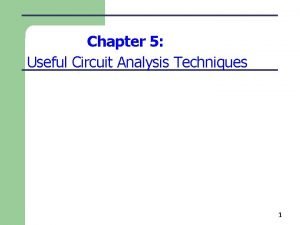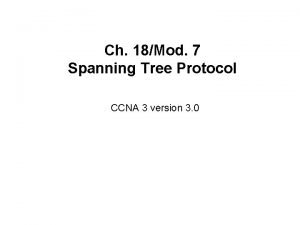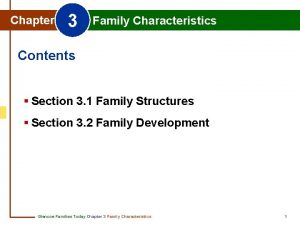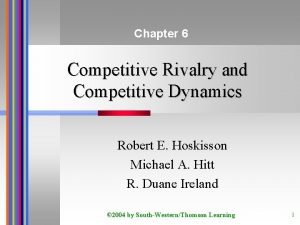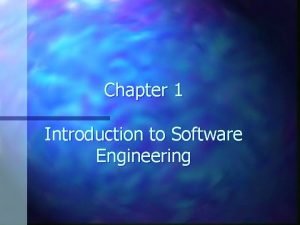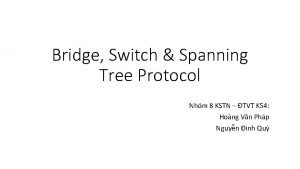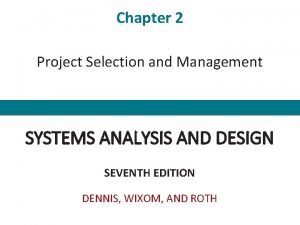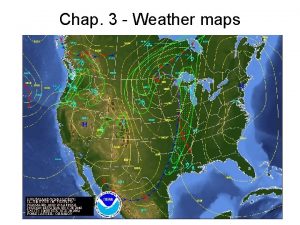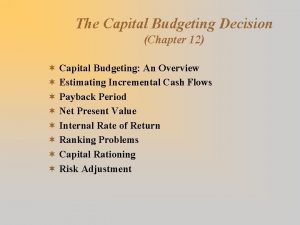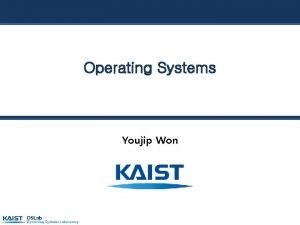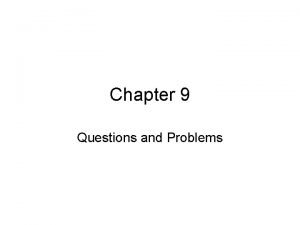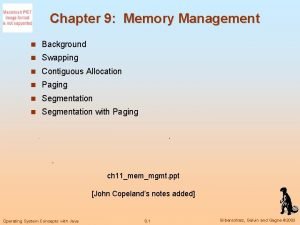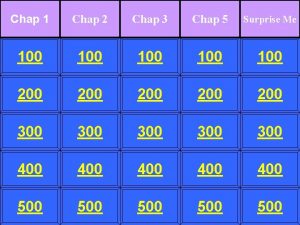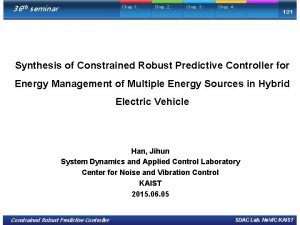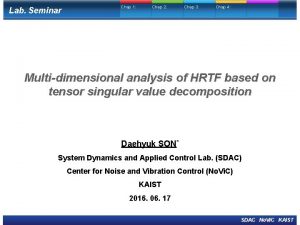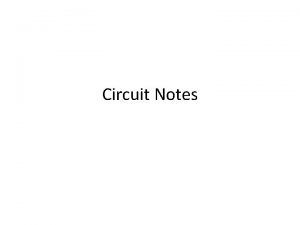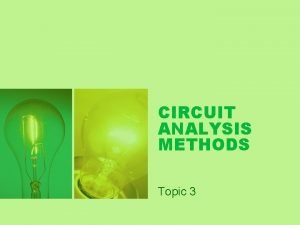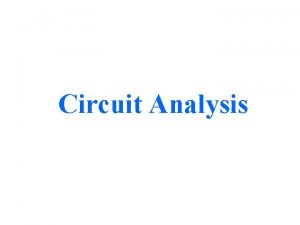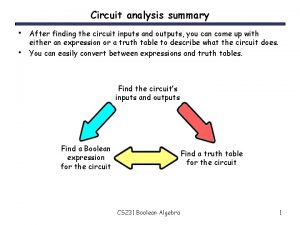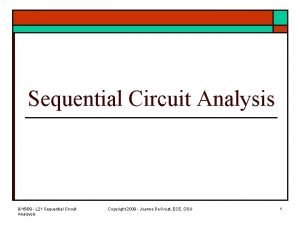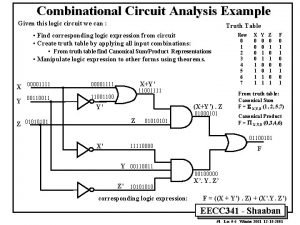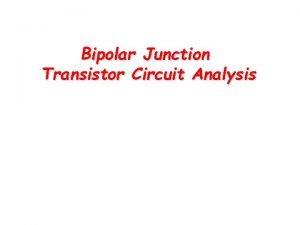Chap 4 Techniques of Circuit Analysis C o







































- Slides: 39

Chap. 4 Techniques of Circuit Analysis C o n t e n t s 4. 1 Terminology 4. 2 Introduction to the Node-Voltage Method 4. 3 The Node-Voltage Method and Dependent Sources 4. 4 The Node-Voltage Method: Some Special Cases 4. 5 Introduction to the Mesh-Current Method 4. 6 The Mesh-Current Method and Dependent Sources 4. 7 The Mesh-Current Method: Some Special Cases 4. 8 The Node-Voltage Method Versus the Mesh-Current Method 4. 9 Source Transformations 4. 10 Thévenin and Norton Equivalents 4. 11 More on Deriving a Thévenin Equivalent 4. 12 Maximum Power Transfer 4. 13 Superposition Objectives 1. 了解並能夠使用節點電壓法求解電路。 2. 了解並能夠使用網目電流法求解電路。 3. 對於特定電路能夠決定節點電壓法或網目電流法何者是較佳的求解方式。 4. 了解電源轉換,並能夠使用它來求解電路。 5. 了解戴維寧和諾頓等效電路的觀念,並能針對電路建立等效電路。 6. 了解電阻負載最大功率轉移之情況,並能計算滿足此情況之負載電阻值。 1

Realistic Resistors 2

4. 1 Terminology 節點 Node A point where two or more circuit elements join 必要節點 Essential node A node where three or more circuit elements join 路徑 Path A trace of adjoining basic elements with no elements included more than once 分支 Branch A path that connects two nodes 必要分支 Essential branch A path which connects two essential nodes without passing through an essential node 迴路 Loop A path whose last node is the same as the starting node 網目 Mesh A loop that does not enclose any other loops 平面電路 Planar circuit A circuit that can be drawn on a plane with no crossing branches Nonplanar 3 Planar

EX 4. 1 Identifying Node, Branch, Mesh and Loop Node a, b, c, d, e, f, and g. Essential node b, c, e, and g. Branch v 1, v 2, R 1, R 2, R 3, R 4, R 5, R 6, R 7, and I. Essential branch v 1 –R 1 , R 2 –R 3 , v 2 –R 4 , R 5, R 6, R 7, and I. Mesh v 1 –R 5 –R 3 –R 2 , v 2 –R 3 –R 6 –R 4 , R 5 –R 7 –R 6 , and R 7 –I. Find two paths that not loops or essential branches. Find two loops that not meshes. 4



EX 4. 2 Using the Node-Voltage Method 1 a) Node 1: Branch currents: b) 7

4. 3 The Node-Voltage Method and Dependent Sources 當有相依電源時,需補上相依電源控制變數的限制方程式。 EX 4. 3 A Circuit with Dependent Source 1 2 Node 1: Node 2: 相依電壓源控制變數 之限制方程式: 8

4. 4 The Node-Voltage Method: Some Special Cases Case A. 當節點電壓值 v 1 = 100 V時,其KCL方程式不需列出, 只需節點 2 之KCL方程式。 Node 2: 9


4. 4 Case B Contd. Supernode Node 1: Supernode: 電壓源限制: 相依電源控制變數: 11

Node-Voltage Analysis of the Amplifier Circuit Node a: Supernode: 電壓源限制: 相依電源控制變數: 12



EX 4. 4 Using the Mesh-Current Method b-(n-1)=7 -(5 -1)=3 a) Mesh a: Mesh b: Mesh c: b) 15

4. 6 The Mesh-Current Method and Dependent Sources 當有相依電源時,需補上相依電源控制變數的限制方程式。 EX 4. 5 A Circuit with Dependent Source Find the power dissipated in the 4 resistor. b-(n-1)=6 -(4 -1)=3 Mesh 1: Mesh 2: Mesh 3: 相依電源控制變數: 16

4. 7 The Mesh-Current Method: Some Special Cases Case A. 當電流源僅有一個網目電流通過時,其KVL方程式不需列出, 直接指定該網目電流。 Mesh 1: Mesh 2: Mesh 3: 17


4. 7 Case B. B Contd. Supermesh: 電流源限制: Mesh b: 19

Mesh-Current Analysis of the Amplifier Circuit Supermesh: 電流源限制: Mesh b: 相依電源控制變數: 20


EX 4. 6 Understanding the Node-Voltage Method v. s. Mesh-Current Method a) Supernode: b) Node a: Node b & 相依電源控制變數: 電壓源限制式與相依電源控制變數: Node 2: Node c: 22

EX 4. 7 Comparing the Node-Voltage and Mesh-Current Methods a) Node o: Node a: Node b: 節點電壓法: ne-1 = 4 -1 = 3 相依電源 控制變數: 網目電流法: be-(ne-1) = 6 -(4 -1) = 3 b) Supermesh: 2個電流源限制式與相依電源控制變數: 23

4. 9 Source Transformations 電源轉換法(source transformation): 電壓源子電路可與電流源子電路互換。 24

EX 4. 8 Using Source Transformations to Solve a Circuit absorbing 25


EX 4. 9 Using Special Source Transformation Techniques a) Use source transformations b) to find the voltage vo. b) Find the power developed by the 250 -V source. c) Find the power developed by the 8 -A source. + - b) (參考原圖) a) (supplied 2800 W) c) (參考原圖) (supplied 480 W) 27


Finding a Thévenin Equivalent a, b 端開路,求解VTh = v 1 = vab。 a, b 端短路,求解isc。 29


EX 4. 10 Finding the Thévenin Equivalent of a Circuit with a Dependent Source 31


EX 4. 11 Finding the Thévenin Equivalent Using a Test Source v. T 為測試電壓源, v. T / i. T 就是RTh。 33

Using the Thévenin Equivalent in the Amplifier Circuit 34

4. 12 Maximum Power Transfer The derivative is zero and p is maximized when CONDITION FOR MAXIMUM POWER TRANSFER (最大功率轉移時的條件) 最大功率轉移量 35

EX 4. 12 Calculating the Condition for Maximum Power Transfer Also, The percentage of the source power delivered to the load is 36



EX 4. 13 Using Superposition to Solve a Circuit 1) 2) 39
 Chap chap slide
Chap chap slide I was in that state when a chap easily turns nasty analysis
I was in that state when a chap easily turns nasty analysis Circuit analysis techniques
Circuit analysis techniques Style chapter 1
Style chapter 1 Passion chap 6
Passion chap 6 Bank run chap 11
Bank run chap 11 Durbin chap
Durbin chap Small and round like a pearl
Small and round like a pearl Kstn chap 18
Kstn chap 18 Close family chapter 3
Close family chapter 3 The origin of species manwha
The origin of species manwha Satisfying needs chapter
Satisfying needs chapter The origin of species - chapter 22
The origin of species - chapter 22 Mad dog symbolism in to kill a mockingbird
Mad dog symbolism in to kill a mockingbird If your right hand offends you
If your right hand offends you Child development chapter 1
Child development chapter 1 Rivalry 1 ch 6
Rivalry 1 ch 6 System engineer chap 1
System engineer chap 1 Chap tree
Chap tree Tree switch
Tree switch Gradualism vs punctuated equilibrium
Gradualism vs punctuated equilibrium Passion chapter 9
Passion chapter 9 Hình cắt kết hợp
Hình cắt kết hợp In the summer chap 22
In the summer chap 22 Selection project 2
Selection project 2 The origin of species - chapter 18
The origin of species - chapter 18 Friendly relationship chapter 12
Friendly relationship chapter 12 Fitness - chapter 1
Fitness - chapter 1 Chap tree
Chap tree Station model for today
Station model for today Chap 23
Chap 23 Payback chap 12
Payback chap 12 Any movement that works the larger muscles of the body
Any movement that works the larger muscles of the body Swapping chap 21
Swapping chap 21 The butterfly inside chapter 10
The butterfly inside chapter 10 Define the relationship chapter 7
Define the relationship chapter 7 Payback ch 9
Payback ch 9 Swapping ch 9
Swapping ch 9 Define the relationship ch 7
Define the relationship ch 7 Breath the same air ch 1
Breath the same air ch 1


